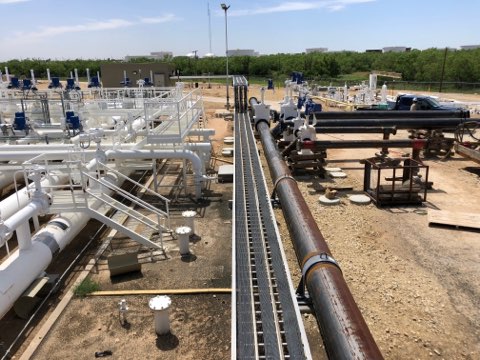Everything About Oil Field Equipment and Pipeline Equipment: Key Insights and Crucial Details
Oil field equipment and pipeline systems play a crucial function in the oil and gas market. They are important for the efficient removal and transport of hydrocarbons. Secret components, such as piercing rigs and tank, directly impact functional success. Advancements in technology guarantee to boost safety and security and efficiency. Comprehending these components is important for anybody associated with or curious about this complicated sector, as it sets the phase for deeper exploration of industry techniques.

Review of Oil Field Equipment
As the demand for oil remains to grow, understanding the tools used in oil areas comes to be progressively important. Oil field equipment includes a wide variety of machinery and tools vital for exploration, extraction, and processing. Key elements include piercing rigs, which are essential for getting to oil storage tanks, and manufacturing equipment, such as separators and pumps, that assist in the removal procedure. Superior Rentals reviews. Additionally, storage space containers play a considerable role in holding crude oil prior to transportation. Security tools, consisting of blowout preventers and stress evaluates, guarantees operational safety and efficiency. Each item of devices functions cohesively to optimize manufacturing and keep reliable process. Knowledge with this devices is important for experts in the market to guarantee effective operations and adherence to security requirements
Sorts Of Drilling Rigs and Their Applications
Drilling rigs serve as the backbone of oil removal operations, with numerous types designed for certain geological problems and operational demands. One of the most usual types include rotating exploration rigs, which make use of a rotating drill bit to penetrate the earth, and cable device rigs, recognized for their percussion drilling technique. For overseas procedures, jack-up rigs and semi-submersible rigs give stability and support in aquatic settings. Additionally, directional boring rigs make it possible for operators to drill at angles, reaching down payments that are not vertically easily accessible. Each rig kind has one-of-a-kind advantages, maximizing performance and security based upon the boring setting. Picking the appropriate rig is necessary for taking full advantage of source removal while minimizing ecological effect and operational prices.

Crucial Pipeline Equipment and Their Features
Pipeline framework is important for the transport of oil and gas from removal websites to processing centers and end-users. Numerous vital devices parts promote this procedure. Pipes themselves function as the main channels, designed to hold up against high stress and corrosive compounds. Pump terminals are crucial for preserving circulation by improving stress along the pipeline. Shutoffs play an essential role in controlling flow and isolating sections for upkeep. Furthermore, installations and ports ensure secure joints between pipe sections. Monitoring systems, consisting of flow meters and stress sensing units, are important for finding leakages and optimizing flow rates. Pigging equipment is employed for upkeep and cleaning, protecting pipeline integrity and performance. With each other, these components develop the foundation of a trustworthy pipeline system.
Advancements and Technologies in Oil and Gas Equipment

Safety And Security and Upkeep Practices in the Oil Industry
While the oil market has actually made significant strides in innovation and performance, the importance of durable safety and maintenance techniques can not be overstated. Efficient safety procedures are necessary to protect employees and the setting, decreasing the risk of mishaps and spills. Routine examinations and maintenance of devices aid gas pipe services near me identify potential problems prior to they intensify, making certain operational honesty. Training programs for workers are crucial, stressing the relevance of safety awareness and emergency situation feedback procedures. In addition, adherence to market guidelines and standards cultivates a society of safety. Implementing innovative tracking technologies can further boost maintenance practices, permitting real-time evaluations of equipment conditions. Eventually, focusing on security and upkeep is important to the sustainability and success of the oil industry.
Often Asked Questions
What Are the Environmental Impacts of Oil Field Equipment?
The environmental impacts of oil field equipment include habitat devastation, water contamination, and air contamination (Superior Oilfield Rentals Texas). In addition, devices malfunction can lead to spills, adversely impacting wild animals and ecological communities, highlighting the requirement for strict laws and tracking
Just How Is Oil Field Equipment Carried to Remote Locations?
Carrying oil field equipment to remote locations usually includes customized cars, helicopters, or barges. Logistics business coordinate courses, guaranteeing tools arrives securely and effectively, thinking about surface and availability to reduce hold-ups and make best use of productivity.
What Regulatory Standards Govern Oil Field Equipment?
Governing standards governing oil field equipment primarily include safety, ecological security, and operational blog efficiency standards. Agencies such as OSHA and EPA impose these policies to guarantee risk-free techniques and decrease eco-friendly impact in oil removal procedures.
What Abilities Are Needed to Run Oil Field Equipment?

Just How Do Oil Rates Affect Equipment Need and Use?
Oil rates significantly affect tools demand and usage. Higher rates usually bring about enhanced expedition and manufacturing activities, driving demand for machinery. Alternatively, lower costs might result in decreased procedures and lowered demand for tools.